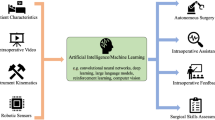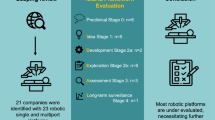Abstract
Background
It is hypothesized that not all surgical trainees are able to reach technical competence despite ongoing practice. The objectives of the study were to assess a trainees’ ability to reach technical competence by assessing learning patterns of the acquisition of surgical skills. Furthermore, it aims to determine whether individuals’ learning patterns were consistent across a range of open and laparoscopic tasks of variable difficulty.
Methods
Sixty-five preclinical medical students participated in a training curriculum with standardized feedback over forty repetitions of the following laparoscopic and open technical tasks: peg transfer (PT), circle cutting (CC), intracorporeal knot tie (IKT), one-handed tie, and simulated laparotomy closure. Data mining techniques were used to analyze the prospectively collected data and stratify the students into four learning clusters. Performance was compared between groups, and learning curve characteristics unique to trainees who have difficulty reaching technical competence were quantified.
Results
Top performers (22–35%) and high performers (32–42%) reached proficiency in all tasks. Moderate performers (25–37%) reached proficiency for all open tasks but not all laparoscopic tasks. Low performers (8–15%) failed to reach proficiency in four of five tasks including all laparoscopic tasks (PT 7.8%; CC 9.4%; IKT 15.6%). Participants in lower performance clusters demonstrated sustained performance disadvantage across tasks, with widely variable learning curves and no evidence of progression towards a plateau phase.
Conclusions
Most students reached proficiency across a range of surgical tasks, but low-performing trainees failed to reach competence in laparoscopic tasks. With increasing use of laparoscopy in surgical practice, screening potential candidates to identify the lowest performers may be beneficial.



Similar content being viewed by others
References
Grantcharov TP, Funch-Jensen P (2009) Can everyone achieve proficiency with the laparoscopic technique? Learning curve patterns in technical skills acquisition. Am J Surg 197:447–449
Cuschieri A (2003) Lest we forget the surgeon. Semin Laparosc Surg 10:141–148
Schijven MP, Jakimowicz J (2004) The learning curve on the Xitact LS 500 laparoscopy simulator: profiles of performance. Surg Endosc 18:121–127
Alvand A, Auplish S, Khan T, Gill HS, Rees JL (2011) Identifying orthopaedic surgeons of the future—The inability of some medical students to achieve competence in basic arthroscopic tasks despite training: a randomised study. J Bone Joint Surg Br 93:1586–1591
Merril RM (2015) Statistical methods in epidemiologic research. Jones and Bartlett Learning, Massachusetts
Dubrowski A, MacRae H (2006) Randomised, controlled study investigating the optimal instructor: student ratios for teaching suturing skills. Med Educ 40:59–63
(2014) FLS Manual skills written instructions and performance guidelines
Downing SM (2004) Reliability: on the reproducibility of assessment data. Med Educ 38:1006–1012
Ritter EM, Scott DJ (2007) Design of a proficiency-based skills training curriculum for the fundamentals of laparoscopic surgery. Surg Innov 14:107–112
Vassiliou MC, Ghitulescu GA, Feldman LS, Stanbridge D, Leffondre K, Sigman HH, Fried GM (2006) The MISTELS program to measure technical skill in laparoscopic surgery: evidence for reliability. Surg Endosc 20:744–747
Tan P-N, Steinbach M, Kumar V (2006) Introduction to Data Mining. Available at: http://www-users.cs.umn.edu/~kumar/dmbook/ch8.pdf
Gallagher AG, Leonard G, Traynor OJ (2009) Role and feasibility of psychomotor and dexterity testing in selection for surgical training. ANZ J Surg 79:108–113
Taguchi Y, Komatsu S, Sakamoto E, Norimizu S, Shingu Y, Hasegawa H (2016) Laparoscopic versus open surgery for complicated appendicitis in adults: a randomized controlled trial. Surg Endosc 30:1705–1712
Soper NJ, Stockmann PT, Dunnegan DL, Ashley SW (1992) Laparoscopic cholecystectomy. The new ‘gold standard’? Arch Surg 127:917–921 discussion 921–923
Louridas M, Szasz P, de Montbrun S, Harris KA, Grantcharov TP (2016) Can we predict technical aptitude? A systematic review. Ann Surg 263:673–691
Tangchitnob EP, Solnik JM, Saad C, Rad S, Ogunyemi D (2011) Identification of background factors that predict baseline laparoscopic skill in 3rd year medical students. J Minim Invasive Gynecol 18:S91–S113
Paschold M, Schroder M, Kauff DW, Gorbauch T, Herzer M, Lang H, Kneist W (2011) Virtual reality laparoscopy: which potential trainee starts with a higher proficiency level? Int J Comput Assist Radiol Surg 6:653–662
Stefanidis D, Korndorffer JR Jr, Black FW, Dunne JB, Sierra R, Touchard CL, Rice DA, Markert RJ, Kastl PR, Scott DJ (2006) Psychomotor testing predicts rate of skill acquisition for proficiency-based laparoscopic skills training. Surgery 140:252–262
Schueneman AL, Pickleman J, Freeark RJ (1985) Age, gender, lateral dominance, and prediction of operative skill among general surgery residents. Surgery 98:506–515
Van Hove C, Perry KA, Spight DH, Wheeler-Mcinvaille K, Diggs BS, Sheppard BC, Jobe BA, O’Rourke RW (2008) Predictors of technical skill acquisition among resident trainees in a laparoscopic skills education program. World J Surg 32:1917–1921
Dimitriou E, Nightingale A, Khazali S, Hatzigeorgiades A, Prendiville W (2009) Predicting individuals with an aptitude in laparoscopy: is it possible? Gynecol Surg 6:S156–S157
Acknowledgements
The authors thank Cameron Irani, George Kerezov, Peter Grantcharov, Shariyar Syed, and Sangita Sequeira for their contributions to this study.
Author information
Authors and Affiliations
Corresponding author
Ethics declarations
Conflict of interest
The authors declare that they have no competing interest.
Disclosures
Dr. Louridas received the laparoscopic equipment and sutures for this study from Covidien and financial support from The Royal College of Physicians and Surgeons of Canada (RCPSC) through the H.S. Morton Exchange Fellowship Fund. Dr. Grantcharov has IP and equity ownership in SST Inc and grants with the Canadian branches of Ethicon, Medtronic, Olympus, and Baxter. Drs. Harris, Szasz, Fecso, Zywiel, Bener and Miss. Lak have no conflicts of interest or financial ties to disclose.
Additional information
This is an original article, with no communication to a society or meeting.
Electronic supplementary material
Below is the link to the electronic supplementary material.
Rights and permissions
About this article
Cite this article
Louridas, M., Szasz, P., Fecso, A.B. et al. Practice does not always make perfect: need for selection curricula in modern surgical training. Surg Endosc 31, 3718–3727 (2017). https://doi.org/10.1007/s00464-017-5572-3
Received:
Accepted:
Published:
Issue Date:
DOI: https://doi.org/10.1007/s00464-017-5572-3




